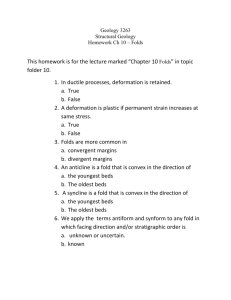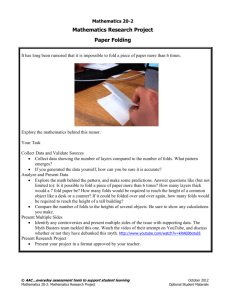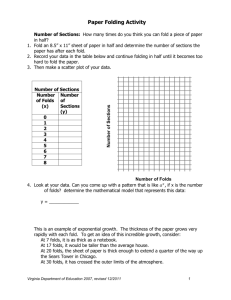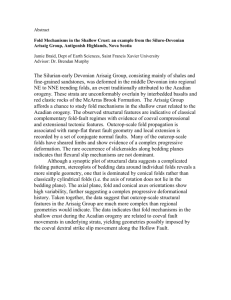FOLDING
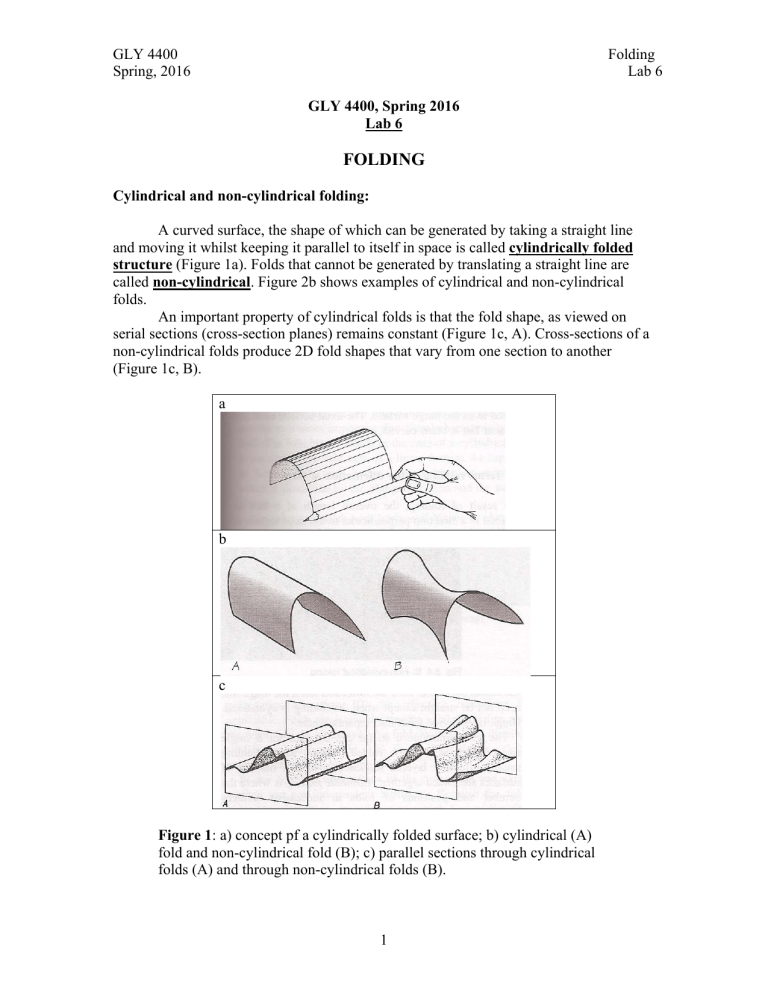
GLY 4400
Spring, 2016
Folding
Lab 6
GLY 4400, Spring 2016
Lab 6
FOLDING
Cylindrical and non-cylindrical folding:
A curved surface, the shape of which can be generated by taking a straight line and moving it whilst keeping it parallel to itself in space is called cylindrically folded structure (Figure 1a). Folds that cannot be generated by translating a straight line are called non-cylindrical . Figure 2b shows examples of cylindrical and non-cylindrical folds.
An important property of cylindrical folds is that the fold shape, as viewed on serial sections (cross-section planes) remains constant (Figure 1c, A). Cross-sections of a non-cylindrical folds produce 2D fold shapes that vary from one section to another
(Figure 1c, B). a b c
Figure 1 : a) concept pf a cylindrically folded surface; b) cylindrical (A) fold and non-cylindrical fold (B); c) parallel sections through cylindrical folds (A) and through non-cylindrical folds (B).
1
GLY 4400
Spring, 2016
Basic geometry of folds:
Folding
Lab 6
Folds
are upward or downward bends of rock layers.
Antiforms
are “upfolds” or
“convex folds”. If the oldest rocks are in the middle, then they are called anticlines .
Synforms are “downfolds” or “concave folds”. If the youngest rocks are in the middle, then they are called synclines . Figure 2 shows two examples of the two common type of fold, an anticline, and a syncline.
In a fold, each stratum is bent around an imaginary axis (the fold axis , or hinge line ). For all strata in a fold, the fold axes lie within the axial plane of the fold. If the fold axis is not horizontal, then it is called plunging fold . Plunge is then the angle between the fold axis and the horizontal. The trend of the plunge is the bearing (compass direction), measured in the direction that the axis in inclined downward. Folds have commonly two sides, or limbs , one on each side of the axial plane. Figure 3 shows the fold terminology for a horizontal fold, and for a plunging fold.
2
GLY 4400
Spring, 2016
Folding
Lab 6
Non-plunging folds have horizontal hinges or plunges of less than 10°, whist vertical folds plunge at 80-90° (Figure 4a). The orientation of the axial surface is described by means of its dip direction and angle of dip. When the axial plane dips less than 10° the adjective recumbent is applicable. Folds are inclined when the axial plane a dips and the term upright is applied to folds with steeply dipping (>80°) axial surfaces. b
Figure 4: a) Names given to folds depending on their orientation; b) direction of closure
In any fold the orientations of the hinge line and axial surface are not independent attributes. Since the fold hinge is a direction which lies within the axial surface, its maximum possible plunge is limited by the angle of dip of the axial surface. For a given axial surface the steepest possible hinge-line plunge is obtained when the fold plunges in the direction of dip of the axial surface. Such folds are called reclined ( Figure 4a).
Another directional feature of the fold is the direction in which the limbs of the folds converge or close. This direction of closure is a direction within the axial surface at right angles to the fold hinge (Figure 4b)
3
GLY 4400
Spring, 2016
Symmetrical and asymmetrical folds:
Folding
Lab 6
When one limb of a fold is the mirror image of the other, and the axial surface is a plane of symmetry, the fold is symmetrical (Figure 5). There is a common misconception that the limbs of a symmetrical fold must have equal dips in opposite directions. This need not to be the case, but the lengths of the limbs must be equal.
Another property of symmetrical folds is that the enveloping surface (a plane or surface containing hinge lines of adjacent folds) is at right angles to the axial surface of each fold.
Asymmetrical folds usually have limbs of unequal length and an enveloping surface which is not perpendicular to the axial surface (Figure 5).
Figure 5: symmetrical and asymmetrical folds
Types of non-cylindrical folds:
Domes and basins are folds of non-cylindrical type since their shape cannot be described by the simple translation of a straight line (Figure 6a). More commonly occurring non-cylindrical folds possess a well-defined but curved hinge line. Four types having the shapes of whalebacks, saddles, canoes and show horns are called periclinal folds (Figure 6b). Periclinal folding gives rise to closed elliptical patterns on the map or outcrop surface
4
GLY 4400
Spring, 2016
Folding
Lab 6 a. b.
Figure 6: a) structure contour pattern of a non-cylindrical fold; b) types of non-cylindrical folds
Structure contours and folds:
Remember that previously we saw how uniformly dipping surfaces are represented by structure contours that are parallel and evenly spaced. Since the strike and dip of a surface generally vary around a fold, the structure contours are generally curved and variably spaced (Figure 7).
Figure 7: Example of structure contour for a folded unit
Non-cylindrical folds give rise to more complex structure contours (Figure 6a).
Concentric circular contours indicate domes and basins. The various types of periclinal folds have characteristic contour arrangements. Lines can be drawn on any contour map marking “valley bottoms” and the “brows of ridges” in the folded structure. These lines are called the trough lines and crest lines respectively (Figure 8)
5
GLY 4400
Spring, 2016
Folding
Lab 6
Figure 8 : A folded surface showing trough and crest lines
Figure 9 shows a plunging fold and a map of its structure contours. If the structure contours are given, the crest line can be drawn in. For a cylindrical fold this line is parallel to the hinge line, so that its plunge is measured straight from the map (it is the trend of the crest line in the downhill direction). The direction of plunge can be shown on maps by an arrow (Figure 9b). The angle of plunge is calculated by solving the triangle in
Figure 9a. Note that the contour spacing mentioned is the separation of the contours measured in the direction of plunge.
For angular folds with planar limbs the crest line can be considered to be the line of intersection of one limb with the other. Therefore the above method to calculate the fold plunge can be applied to calculate the plunge of the line of intersection of any two surfaces. If both surfaces are planar (dip uniformly) their line of intersection will be straight (plunge uniformly) (Figure 9a). If, instead of structure contours, 2 limb dips only are known, the plunge can still be calculated.
6
GLY 4400
Spring, 2016
Folding
Lab 6
Figure 9: Calculation of the fold plunge from structure contours
7

